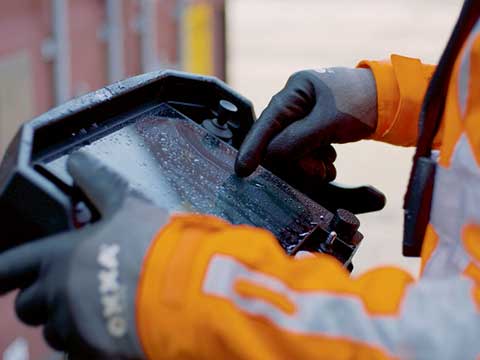
Posted to News on 28th Feb 2024, 14:00
Touchscreens: the top outdoor control choice
Thanks to the rise of the smartphone, we have all become accustomed to the touchscreen. However, the application possibilities of touchscreens go far beyond what we are used to from our smartphone. The touchscreen is also gaining ground for operating machines and devices outdoors, as the experts at SCHURTER explain.

Apart from many advantages, the smartphone also has its limitations: a smartphone is difficult to read in bright sunlight and the screen quickly cracks if the device is dropped or hits a hard object. Yet there are plenty of ways to make touchscreens suitable for use in harsh outdoor conditions.
For this, a number of factors need to be taken into account in the design. Outdoor control panels must be capable of withstanding various weather conditions, including heavy usage and prolonged exposure to sunlight.
Weather influences and moisture
If water or another liquid hits the touch panel surface, it can cause unintended actions or malfunctions. Touchscreens used outdoors should therefore at least be resistant to rain, but often even to running water.
In medical or maritime applications, moreover, the salinity of the water is a factor to consider, while these control panels often have to operate in extreme temperatures as well.
One way to make touch panels resistant to moisture is to seal the front glass all around the housing by means of gap encapsulation. Furthermore, the structure of the sensor design and the algorithms of the firmware can be optimised especially for conductive liquids such as salt water.
In addition, the control panels in outdoor applications are often exposed to extreme temperature fluctuations such as icy cold in winter or intense heat in summer. This requires the use of suitable materials and a robust construction to ensure functionality.
Legibility and sunlight
To be able to use a touchscreen even outdoors in bright sunlight, extra attention must be paid to readability. In addition, prolonged exposure to the sun's UV rays can damage the touchscreen over time, resulting in a yellowed, opaque or even cracked screen. This not only detracts from the application's appearance, it can also affect its performance. The materials used must therefore be resistant to UV radiation, even with prolonged exposure to sunlight.
Here, UV-filtering materials are often chosen, certified according to the standards ASTM G154 and MIL-STD-810H based on 1,000 hours of exposure in an accelerated UV ageing test.
For optimum readability, the screen can be equipped with a non-reflective surface. In addition, an LCD display should be chosen that offers a sharp, clear image and colour fidelity.
For outdoor use, resistive touchscreen solutions are available with a film between two layers of glass (called glass-film-glass or GFG) or low-reflective glass, which is readable in direct sunlight. To further enhance readability, optical bonding of the display with the glass front panel and sensor can be chosen. This optical bonding eliminates the air gap in the structure and thus minimises reflections.
In addition, optical bonding increases the mechanical stability of the control panel. With reduced reflection, this technique provides a wider viewing angle, making the display more readable from different positions.
Tough conditions
Machines for outdoor industrial use must withstand harsh conditions. Even in hazardous areas, devices must be able to be operated reliably. But even applications placed in public spaces sometimes have to endure tough conditions. Vandalism resistance is an important requirement for these applications.
To ensure the safety and functionality of touchscreens even under these extreme conditions, they can be fitted with an extra-thick front panel. Polymer composite based materials can even be used to make unbreakable front panels that can withstand impacts up to the IK 10 standard.
In such applications, the front panel is also equipped with an additional foil for increased protection against cracking and shattering. Thanks to a robust housing and the use of extra-strong components, control panels can be equipped with the necessary mechanical strength to effortlessly withstand all expected environmental influences.
Developing touchscreens for outdoor use requires specialist knowledge. After all, every application has a specific combination of circumstances and requirements. Based on many years of experience, SCHURTER engineers find the right combination of components, materials, software, assembly and integration for every situation.
SCHURTER's specialists analyse the specific application requirements and shape the design so that the touch panels are optimally suited for the intended outdoor use. Expertise and proactive advice throughout the development process result in reliable end products of the highest quality.
Want the latest machine building news straight to your inbox? Become a MachineBuilding member for free today >>
Unit 3, Mildshires Business Park
Smeaton Close
HP19 8HL
UNITED KINGDOM
+44 (0) 1296 319 000

















